- Home
- Bill Bryson
The Road to Little Dribbling Page 19
The Road to Little Dribbling Read online
Page 19
Not everyone is entirely happy with the new arrangements. For many American visitors Stonehenge is just one stop on a whirlwind day tour from London that also takes in Windsor Castle, Bath and sometimes Stratford-upon-Avon, too. It used to be that such visitors could get the complete Stonehenge experience – see the stones, look around the gift shop, discover to their dismay that there were no nachos or pizzas for sale, buy a box of fudge to eat until something cheesier became available, visit the restroom, put on a plastic poncho because it was evidently time to look a little ridiculous, then climb back on the coach and depart – all in about ten minutes. Now, with the new visitor centre more than a mile from the stones, it takes that long just to drive to the site, which is more time than people doing the south of England in a day can comfortably spare.
I, however, was enchanted from the moment of arrival. The admission price of £14.90 brought only a small cry of pain to my lips. The new exhibition space was excellent – or as excellent as these things can ever be. It is an impossible task. The exhibition must satisfy people with brains, interests and language skills of variable capacities, and it must keep the crowds moving along, to accommodate the steady flow of new arrivals from behind, so it can’t invite lingering. But once we have allowed for that, it is jolly good.
A great deal of what we know about Stonehenge is surprisingly recent. For most of my lifetime, Stonehenge was thought to date from about 1400 BC, but now it is known to be a thousand years older than that, and a large part of the surrounding earthworks are older still. The cursus, a giant oval ditch nearly two miles long, predates Stonehenge by hundreds of years, as do many of the burial mounds and processional avenues. Something about this site drew people long before anyone decided to erect stones there. People came from all over – from continental Europe and the Highlands of Scotland – but for what purposes precisely will probably never be known.
Nothing of course is more mysterious than the great stone circle itself. The Stonehenge we see today was built from two types of stone: sarsen, an immensely hard sandstone that forms the giant uprights, and bluestone, which was used for the smaller encircling stones. The sarsens were brought from the Marlborough Downs, which are generally described as nearby, but you try dragging an 80,000-pound rock twenty miles over open ground and see how often you use the word ‘nearby’. Today seventeen of the big stones are still standing, but once there may have been thirty. The smaller but more numerous bluestones – eighty or so altogether – came 180 miles from the Preseli Hills of western Wales. That is truly extraordinary. How did people in lowland England know about the existence of special stones on a mountaintop in distant Wales? If they thought the stones were sacred, as they clearly must have, why didn’t they build their shrine in Wales? Why go to the immense effort of bringing them all the way to Salisbury Plain? It wasn’t to help complete the great stone circle that we see today. We now know that the bluestones were brought to Stonehenge five hundred years before the great stone circle was built. This is another new fact, known only since 2009. As with everything at Stonehenge, the more we learn the more wondrous and inexplicable it becomes.
When I first came to Stonehenge in the early 1970s, you were still allowed to wander among the stones, to touch them and lounge against them and perch upon them. Soon afterwards, however, that practice was stopped in the interests of preservation and everyone was made to stay on an outer encircling path, which is clearly a shame. At the new visitor centre they have addressed this problem by placing two full-sized replicas – one a bluestone, one a sarsen – just outside. Visitors can feel and inspect both types of stone before they see the real thing, which is a great help. Sarsen is a sandstone, but harder than granite. The block outside the visitor centre lies on its side on wooden rollers, to show how it is believed they were moved. It is a brilliant presentational stroke because it conveys the immensity and weight of the thing instantly.
Most people travel to the Stonehenge circle from the visitor centre on a conveyance called a land train, but a discerning few elect to walk – a much better option because it gives you a chance to settle into the landscape and get a sense of the spaciousness of Salisbury Plain. You see the stones for the first time from about a half-mile away and below you as you emerge from a stand of trees at the top of a long, low hill.
At first sight, they seem surprisingly modest, dinky even – we are used, after all, to seeing cathedrals and other mighty structures – but with a little effort you can imagine the sense of awe the circle must have evoked in people who had never seen anything remotely on this scale. And it actually takes no effort at all to be struck silent by the beauty and perfect majesty of it. You realize at once that this is one of the most beautiful and extraordinary things ever created by humans, and it is all the more remarkable for being totally without precedent. The wonder of Stonehenge isn’t just the energy and organizational skills necessary to get it built, but the vision of it.
How, in every sense of the word, did they do it? How did anybody get the idea, how did they persuade hundreds of people to join in the endeavour, how did they find and select the right stones, haul them across the country, shape them to perfection, heave them into position? How anyone could conceive such a harmonious assemblage in a world with nothing to compare them with is a mystery way beyond answering. And it was all done by people who had no metals to work with, no tools sharper than flint or antler.
Why it was built where it was is a question not easy to answer, even speculatively. The site is not especially prominent. It isn’t served by a mighty river or bounded by natural grandeur. The materials necessary to build Stonehenge were all far away. There must have been other places easier for pilgrims to reach. Yet for some reason unknown numbers of people invested huge amounts of energy and thought into making one of the most literally perfect structures ever made. The fastidiousness of it is staggering. The site slopes, but the builders allowed for that, carefully making the uprights different heights so that the lintels would be perfectly horizontal all the way round. The stones are not standing on top of the ground, like dominoes on a tabletop, but are embedded in the earth, in some cases up to a depth of eight feet, to keep them from toppling. Somebody wanted them still to be standing 4,500 years later. The sides of the lintels are gently curved, so that they can perfectly cap a circular structure. This was a meticulously engineered monument.
And yet having taken all that care, it now appears that Stonehenge was used for no more than a couple of generations and then abandoned. What made people walk away from it is likely to remain for ever the biggest mystery of all.
As you might expect, all this left me in a reflective frame of mind. Trudging back up the long, low hill, I wondered idly what the builders of Stonehenge would have created if they’d had bulldozers and big trucks for moving materials and computers to help them design. What would they have created if they had had all the tools we have? Then I crested the brow of the hill with a view down to the visitor centre, with its café and gift shop, its land trains and giant car park, and realized I was almost certainly looking at it.
I was headed for Norfolk, but the Natural History Museum in London had a special exhibition that I had been wanting to see for some time that was highly relevant to East Anglia, so I stopped there on the way. The Natural History Museum is a glorious, overwrought building with a massive central hall dominated by the skeleton of a Tyrannosaurus rex, which seems to be poised to attack and devour anyone coming through the front entrance, which in fact wouldn’t be a bad idea at all these days.
I remember the Natural History Museum as being packed with stuff and seeming almost infinite. The long downstairs corridors, softly lit and tranquil, were filled with tall glass cases of stuffed animals of every imaginable type. It was like being in a frozen zoo. You could study the animals closely, observe their steady gaze and fur and musculature, get a sense of their strength or fleetness, marvel at life’s diverse ingenuity. It was fascinating, even thrilling. Above all, I remember the Natural
History Museum as being almost empty of other visitors and very quiet, like a library.
Now it is never calm or empty. It is permanently bright and noisy and horrible. Where a long gallery full of stuffed animals and glass cases used to beckon there is now a gift shop. It is not even a gift shop really. It’s a toy store. Gone are the days when you could fob your children off with a pencil case and a rubber. This was like Hamley’s.
The crowds were loud, intense and mostly foreign. The atmosphere was that of a Middle Eastern souk or the streets around a football ground before a big match. There was nothing agreeable about it at all. I threaded my way through the throngs to a special exhibition called ‘One Million Years of the Human Story’, which was all about the first people in Britain. I had been wanting to see it for some weeks but particularly I wanted to see it now when I was en route to East Anglia, for that is where the human story in Britain begins.
People, it turns out, have come and gone a lot in Britain. The country has been occupied and abandoned at least seven times. These comings and goings don’t always make a lot of sense. Half a million years ago Britain had a fairly substantial population, but then for about 100,000 years no one was in Britain at all, as far as can be told, even though that was a time when the climate was mild and food abundant. At other times when the country was covered in ice hundreds of feet thick, people clambered over every obstacle to get here. Throughout the whole of the long haul of the palaeolithic period, people came and went in ways that seemed perversely at variance with what nature was telling them to do. I suppose it could be said they still do.
In 2000 an amateur archaeologist named Mike Chambers, while walking along the beach at Happisburgh, Norfolk, noticed a flaked flint sticking out of a crumbly sea cliff at a depth where worked flints shouldn’t be. A team of academic archaeologists moved in and over the next five years extracted thirty-two more pieces of worked flint – that is, human artefacts – which proved to come from an extremely remote past, left by a people so distant from us in time that we know nothing about them. The Happisburgh people were not modern humans. They weren’t even like John Prescott. They are usually assigned to a species called Homo antecessor, which means ‘first people’, but that’s just a guess. They left no direct traces of themselves, only the flinty remnants of their industry. Whoever they were, they were the earliest people yet found in Britain, from nearly a million years ago (hence the name of the exhibition).
At least two other early species of humans came and went in Britain before Homo sapiens arrived: Homo heidelbergensis and Homo neanderthalensis (which is to say the Neanderthals). The only permanent occupation so far is the present one, and that dates from just 12,000 years ago, which means that Britain is actually one of the more recent places in the world to become inhabited by modern people. In this sense it is much younger than the Americas or Australia.
The exhibition was everything an exhibition should be – thoughtful, informative, engaging, soothingly lit, blissfully quiet. I was one of just three visitors, no doubt because it was also rather expensive at £9. The curators had assembled a great deal of material that had never been brought together before – the earliest Neanderthal skull in Britain, the world’s most ancient spear, hand axes and scrapers of all shapes and sizes, including those found at Happisburgh – so you could follow the whole story of human occupation over nearly a million years. But the most mesmerizing feature were two life-sized, and wholly lifelike, models – one of a Neanderthal, the other of an early modern human. They were made by two Dutch brothers, Adrie and Alfons Kennis, who have a genius – that’s really not too strong a word – for human reconstructions. The models were fashioned to look like individuals, not archetypes, so that entering the room was like being with an actual, living Neanderthal and an equally actual early human, a quite uncanny experience.
The Neanderthal was short, about five feet four inches tall, but solidly built and rugged-looking. Neanderthals are a wonderful mystery. Their brains were bigger than ours, for one thing. They lived through ice ages, so needed clothing, but left no evidence that they ever learned to sew. For a long time it was thought that we didn’t breed with them, but now we know that we are 2 per cent Neanderthals ourselves. I don’t know why scientists have been so resistant to the idea of interbreeding. You look at the modern humans that a lot of people have slept with and it is hardly a surprise if a Neanderthal maiden or two might have twinkled by the campfire light. Among the genetic gifts the Neanderthals passed on to us, it seems, is ginger hair, bless them. Alongside the Neanderthal, the early modern human looked delicate, almost wispy. He was several inches taller but considerably less robust. There is no question that a Neanderthal could easily beat us up. So, too, presumably could their women, which may be why we are only 2 per cent Neanderthals instead of 50 per cent. Those bitches were too scary for us.
Nearby was a plaster model of the head of a Homo antecessor, looking uncommonly happy for some reason. Homo antecessor was an entirely new species discovered in northern Spain in 1994. They have never been found anywhere else. No one actually knows that the Norfolk people were Homo antecessor. They are assumed to be because they come from the right period, but they could be something else altogether, including even a new species. The model in the Natural History Museum suggested a humanlike creature that was good-natured but none too bright, but this, too, is just a guess.
The exhibition ended, inevitably, with a pop-up gift shop. I don’t blame the museum exactly. This is what happens when institutions are told to offer free general admission but also somehow pay their own way. I wouldn’t be at all surprised on my next visit to find that the space is occupied by a Tesco Express.
I went and had a look at the rest of the museum. The displays everywhere were dated and threadbare. The room on ‘Creepy Crawlies’, which I don’t think has changed since I took my own kids there in the 1980s, is relentlessly jokey in a way that makes you want to shoot yourself through the head. Many of the signs were half worn away; this was slowly becoming the Na ural Hist ry Mus um. The labels everywhere were hopelessly lacking in enthusiasm and thought. In the ecology section, a picture of a dolphin, head out of the water looking happy and inquisitive, was accompanied by this message (given here in full): ‘In 2004 MPs called for an end to sea bass fishing in Southwest England following pressure from campaigners to reduce the number of dolphins drowned in trawler nets each year.’ I’m sorry, but we just have to look at this ridiculous statement for a minute. First of all, 2004 was a long time ago. Has anything happened since then? Certainly nothing has happened to this label since then. How many MPs called for action? Three? Five hundred? What? Did they introduce legislation? Was it acted on? Was there a reason for particular concern about sea bass fishing in Southwest England? Why not all fishing around Britain – why not all fishing in the world? Even when this information was fresh, it was lame and inadequate. Now it is just out of date and an embarrassment to museumology, or whatever is the word for what these people do. All the museum was like this. The stuffed animals in glass cases that once enraptured my children have been put in storage, presumably deemed too old-fashioned for twenty-first-century display.
The mezzanine overlooking the grand hall used to have a good section on anthropology on one side and yet more stuffed animals on the other. Now the anthropology section is just an empty corridor and the other side is fully occupied by a café – one of at least five in the building. Slowly it dawned on me what’s going on here. The Natural History Museum can’t afford to be a museum any more, so the directors are stealthily turning it into a food court. Now when I bring my grandchildren, we can sit with refreshments and I can tell them how it used to be. ‘Over there where that ice cream machine is used to be a glass case with a polar bear in it. Drink up and I’ll take you down and show you where the blue whale used to be. We can get some curly fries there.’ It won’t be as informative or educational, but I expect it will be financially viable.
Just beyond this new upstairs caf�
� was a lone glass case, and for a moment I thought I had come across an overlooked relic of the way the museum used to be when it was exciting and interesting, but it was a false alarm. It was essentially just an advertisement for Down House, Charles Darwin’s home in Kent. There wasn’t any information about Darwin’s life and achievements, nothing about the Beagle voyage or evolution or anything that could be called mildly instructive, just a recommendation to go and see his house.
It didn’t say anything at all about what the snack facilities were like, however, so I decided not to chance it.
Chapter 14
East Anglia
I
ON A LOVELY bright summer’s morning, I was walking the Norfolk coast path between Holkham and Blakeney when I came round a bend and found the way temporarily blocked by a woman and her dog. I stood with the woman and we watched together as the dog dolefully extruded three soft lozenges on to the path.
‘Don’t you think that’s a little disgusting, right on the path and all?’ I asked in a tone of genuine enquiry.
‘I’m local,’ she said as if that explained everything. She was well spoken.
‘And that gives you the right to let your dog shit on the paths?’

 Notes from a Small Island
Notes from a Small Island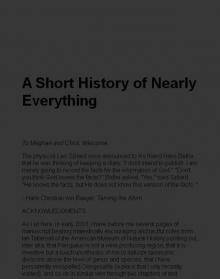 A Short History of Nearly Everything
A Short History of Nearly Everything A Walk in the Woods
A Walk in the Woods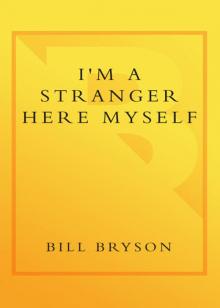 I'm a Stranger Here Myself
I'm a Stranger Here Myself The Mother Tongue
The Mother Tongue Shakespeare
Shakespeare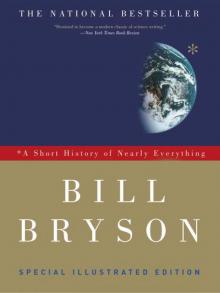 A Short History of Nearly Everything: Special Illustrated Edition
A Short History of Nearly Everything: Special Illustrated Edition The Best American Travel Writing 2016
The Best American Travel Writing 2016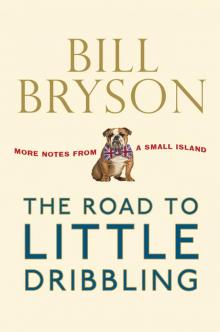 The Road to Little Dribbling
The Road to Little Dribbling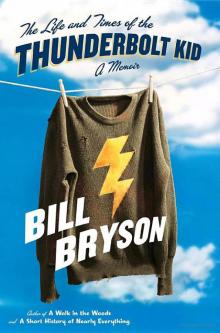 The Life And Times Of The Thunderbolt Kid: A Memoir (v5.0)
The Life And Times Of The Thunderbolt Kid: A Memoir (v5.0) Made In America
Made In America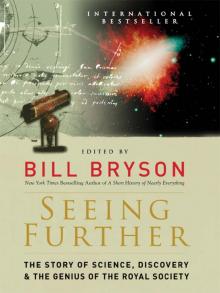 Seeing Further
Seeing Further Shakespeare: The World as Stage
Shakespeare: The World as Stage The Life and Times of the Thunderbolt Kid
The Life and Times of the Thunderbolt Kid At Home
At Home Bryson's Dictionary For Writers And Editors (v5.0)
Bryson's Dictionary For Writers And Editors (v5.0) Neither Here Nor There
Neither Here Nor There Bill Bryson's African Diary
Bill Bryson's African Diary